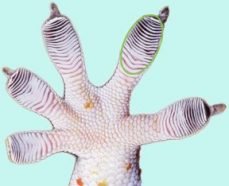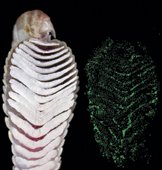Geckos’ Sticky Feet Clean Themselves
Tiny hairs on gecko toes can stay nearly dirtfree, helping the lizards cling to ceilings.
By Emily Sohn
Geckos are in the news—again.
A few years ago, Kellar Autumn of Lewis & Clark College in Portland, Ore., solved the mystery of how geckos stick to ceilings (see How a gecko defies gravity). The feet of these lizards have lots of tiny, branched hairs called setae, which work as a powerful sort of glue. This discovery led him to ask even more questions about the clingy creatures.
 |
|
A gecko’s toes have special, sticky ridges made up of tiny hairs, or setae, that allow them to stick to surfaces. |
| Proceedings of the National Academy of Sciences |
For one thing, Autumn had never seen a gecko clean its setae. So how, he wondered, could the animals do all that scrambling around without their setae getting clogged full of dirt and other gunk?
To investigate this question, Autumn and colleague Wendy Hansen, now at the University of California, Berkeley, coated gecko feet with fake “dirt” particles—extremely tiny glass spheres (microspheres). Then, they had the geckos walk around on a glass plate.
At first, the particles made the geckos’ feet less sticky. As they walked, though, their grip improved. The researchers suspected that the animals’ feet were cleaning themselves by shedding the microspheres.
 |
|
When the underside of a gecko toe (left) was dusted with microspheres and pressed onto glass, millions of sticky fibers in the thin, platelike structures shed microspheres onto the glass, leaving a print visible under laser light (right). |
| Kellar Autumn |
Intrigued by this result, the scientist took a closer look. Using principles from physics and geometry, they figured out that between 26 and 59 fibers would have to cling to a single microsphere for the sphere to stay on a gecko’s toe. Under a powerful microscope, however, it became clear that this hardly ever happened.
With each step by a gecko with coated toes, more microspheres stick to the surface than to a gecko’s feet. This happens because the microspheres are more strongly attracted to the surface than they are to the branched hairs on a gecko’s toes.
If scientists can figure out how to mimic the gecko’s self-cleaning strategy, our future could include life-saving gloves for mountain climbers, space rovers that could crawl gecko-like across the ups and downs of dusty Mars, and drop-proof baseball gloves, among other cool inventions.—E. Sohn
Going Deeper:
Weiss, Peter. 2005. Twinkle toes: How geckos’ sticky feet stay clean. Science News 167(Jan. 8):21-22. Available at http://www.sciencenews.org/articles/20050108/fob6.asp .
McDonagh, Sorcha. 2004. Gooey secrets of mussel power. Science News for Kids (Jan. 11). Available at http://www.sciencenewsforkids.org/articles/20040121/Note2.asp .
______. 2003. Sticking around with gecko tape. Science News for Kids (June 11). Available at http://www.sciencenewsforkids.org/articles/20030611/Note2.asp .
Sohn, E. 2004. Gecko night vision. Science News for Kids (Dec. 8). Available at http://www.sciencenewsforkids.org/articles/20041208/Note3.asp .
______. 2004. Inspired by nature. Science News for Kids (Nov. 3). Available at http://www.sciencenewsforkids.org/articles/20041103/Feature1.asp .
______. 2003. How a gecko defies gravity. Science News for Kids (Nov. 19). Available at http://www.sciencenewsforkids.org/articles/20031119/Feature1.asp .







